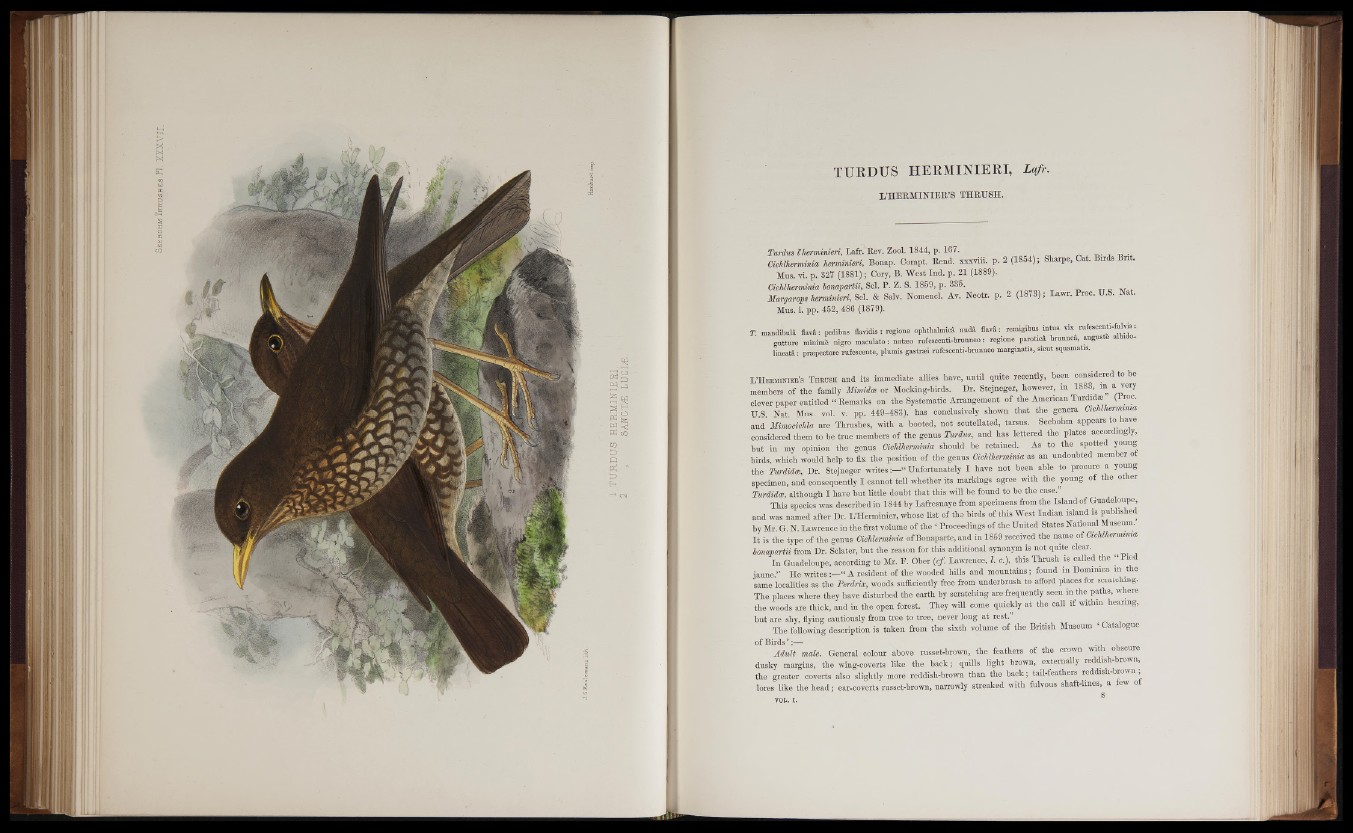
TURDUS HERMINIERI, Lafr.
L ’HERMINIER’S THRUSH.
Turdus V herminieri, Lafr. Rev. Zool. 1844, p. 167.
Cichlherminia herminieri, Bonap. Compt. Bend, xxxviii. p. 2 (1854); Sharpe, Cat. Birds Bnt.
Mus. vi. p. 327 (1881); Cory, B. West Ind. p. 21 (1889).
Cichlherminia honapartii, Sei. P. Z. S. 1859, p. 335.
Margarops herminieri, Sei. & Salv. Nomencl. A t. Neotr. p. 2 (1873); Lawr. Proo. U.S. Nat.
Mus. i. pp. 452, 486 (1879).
T. mandibulä flavit: pedibus flavidis : regione ophthalmic^ nudfi, flavd: reimgibus intus vixrufescenti-fidvis.
gutture nigro jnaculato: notmo rufescenti-brunneo: regione paroticÄ brnnned, anguste albido.
lineatd: pSpectore rufescente, plumia gastnei rufescenti-brunneo marginatis, sicut squamatis.
L’Hekmikiee’s Thrüsh and its immediate allies have, until quite recently, been considered to be
members of tbe family Mimidm or Mocking-birds. Dr. Stejneger, however, in 1 8 8 3 , in a very
clever paper entitled | Bemarks on tbe Systematic Arrangement of the American Turiidas (Proc.
U.S. Nat. Mus.-vol. V. pp. 4 4 9 - 4 8 3 ) , has conclusively shown that the genera Cichlhermmia
and Mimocichla are Thrushes, with a booted, not scutellated, tarsus. Seebohm appears to have
-considered them to be true members of the genus Turdus, and has lettered the plates according y,
but in my opinion the genus Cichlherminia should be retained. As to the spotted young
birds, which would help to fix the position of the genus Cichlherminia as an undoubted member ot
the Twrdidae, Dr. Stejneger w r it e sU n f o r tu n a t e ly I have not been able to procure a young
specimen, and consequently I cannot tell whether its markings agree with the jo u n g of the other
Turdidce, although I have but little doubt that this will be foiind to be the case,”
This species was described in 1844 by Lafresnaye from specimens from the I s l a n d of Guadeloupe,
and was named after Dr. L’Herminier, whose list of the birds of this West Indian island is published
by Mr. G. N. Lawrence in the first volume of the 1 Proceedings of the United States National Museum.
It is the type of the genus Ochlerminia of Bonaparte, and in 1859 received the name of Oichlhermmw
honapartii from Dr. Sclater, but the reason for this additional synonym is not quite clear.
In Guadeloupe, according to Mr. P. Ober (cf. Lawrence, I. c.), this Thrush is called the “ Pied
jaune.” He writes : J | ‘ A resident of the wooded hills and mountains; found in Dominica m the
same localities as the Perdrix, woods sufficiently free from underbrush to afford places for scratching.
The places where they have disturbed the earth by scratching are frequently seen in the paths, where
the woods are thick, and in the open forest. They will come quickly at the call i f withm hearing,
but are shy, flying cautiously from tree to tree, never long at rest.
The following description is taken from the sixth volume of the British Museum ‘ Catalogue
of Birds *;— .
Adult male. General colour above russet-brown, the feathers of the crown wit o scure
dusky margins, the wing-coverts like the back; quills light brown, externally reddis rown,
the greater coverts also slightly more reddish-brown than the back; tail-feathers reddis rown,
lores like the head; ear-coverts russet-brown, narrowly streaked with fulvous shaft-lines, a few o